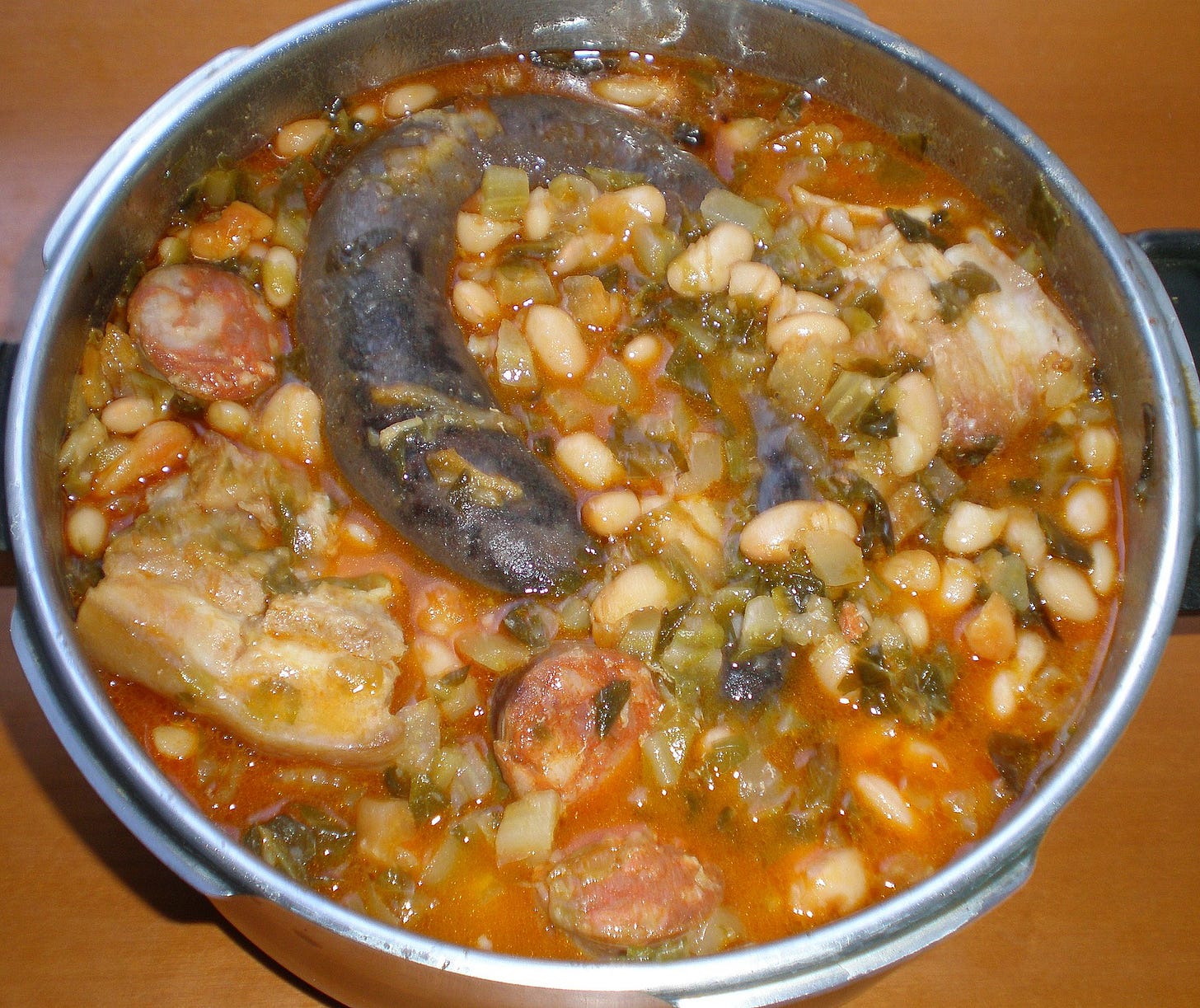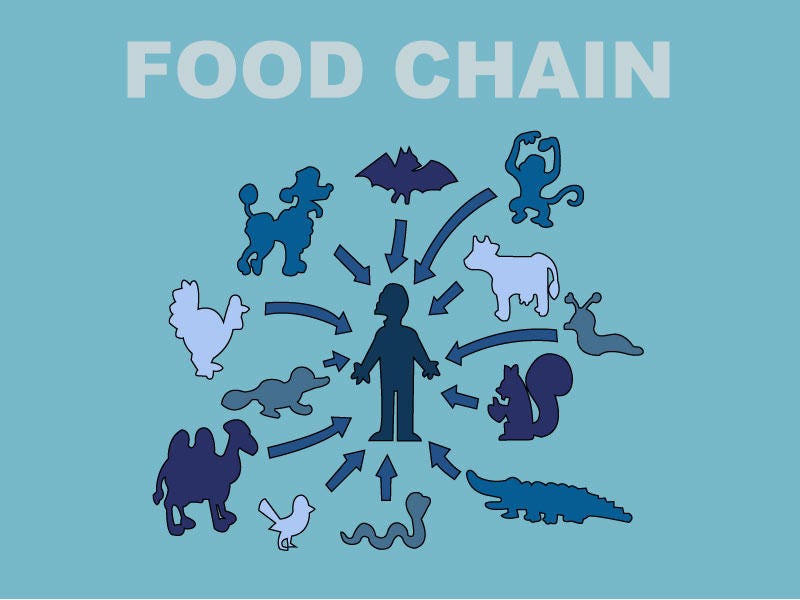I have an aspiration. An aim. A holy grail. And its name? Perpetual stew.
It goes by many names: forever soup, hunter's pot, hunter's stew, bottomless broth, master stock, mother broth, or huge motherfucking pile of hot shit you can boogie with for as long as you want.1
The concept is the same with all of these — a soup-like concoction that continues cooking indefinitely.
While hunter’s stew exists in forms across the world, I first came across it as a reference to old English inns. Supposedly, many would have a big pot of perpetual stew on the go, with visitors and cooks flinging fresh things into the boiling container each and every day.
And, man, it rules. A vat of on-the-go chunky soup that’s always available for a snack, its flavour both constantly shifting and, yet, traces of previous editions remaining — there’s little more Dudes Rock than that.
A perpetual stew is like the ship of Theseus, but, instead of a boring-ass ship, it’s goddamn bottomless broth.
Back in around 2016, I actually tried to create one.
I was living in a houseshare at the time and we had a slow cooker (or crockpot if you’re American), so I decided to give it a go. With a house full of hungry boys constantly cooking, a perpetual stew seemed both possible and sensible.
We had scraps to constantly chuck in the pot, as well as the sort of insatiable appetites only an endless series of poor life decisions can deliver.
Really, it’d be a crime not to have a hunter’s pot on the go.
This, as regular readers of The Rectangle can imagine, didn’t go well.
I put an old chicken carcass in the slow cooker along with an array of vegetables, swiftly forgot about it, and came back several days later to a scum-covered, melted, greasy mess.
It was not what I envisioned. After the failure, I pushed my want for perpetual stew deep down to rest with all my other traumas and disappointments.
Yet, in the past several months, my desire has rushed back.
One reason for this has been the revitalisation of the trend by the person behind the Depths of Wikipedia social media accounts, Annie Rauwerda. This is her TikTok that caused a storm:
 Tiktok failed to load.
Tiktok failed to load.Enable 3rd party cookies or use another browser
Rauwerda kept a perpetual stew going for around 60 days — even starting a club while doing so.
This was unequivocally awesome, but is just the latest in a long line of amazing perpetual stew stories. I remember with joy the Louro Perpetual Stew Twitter account back in 2012, run by a chef called Dave Santos.
Then, we have the truly historical examples of forever soups. Oden, a type of Japanese stew, is made using a broth that some restaurants have been maturing for 60 years.
And let’s not forget Wattana Panich, a Thai noodle restaurant that’s been using a form of the soup base for close to 50 years.
All around me is inspiration, people thriving with perpetual stews. Could it be time to re-enter the fray?
I’m not so sure.
What unites all the above examples is people. Whether it’s having an open invitation to stew or running a restaurant, it seems you need a constant footfall for a bottomless broth to work.
I have nothing against people, but I kinda do. Plus, I value my alone time. The other option would be eating stew every day. But, I don’t really want to do that.
The next natural reaction (for me at least) is to then decry the whole concept of perpetual stew to protect my fragile ego.
And, believe me, the evidence is out there to do this successfully.
For example, this article on MEL Magazine interviews a gamut of experts who claim that perpetual stew being eaten in medieval times is a total myth, it has almost no benefits, and it doesn’t taste any different to a regular stew.
There’s part of me that really, really wants to get on board with that — but I can’t.
The stew is too alluring.

After some soul searching, I came to a conclusion why I can’t shake perpetual stew. In a way, it’s similar to why people got so obsessed with fermentation and baking bread and during the pandemic. Not only is there a traditional element to these practices, but there’s the sense of life, of progression. Most food exists in a short moment; you make it and eat it. It’s finite.
Things like kimchi, sourdough, and perpetual stews break this trend. They don’t have such a defined beginning and end, they change and evolve, stretching out almost as long as you see fit.
If I wanted to get all Freudian, I’d say that these long-lived foods could represent an eschewing of typical notions of death displayed by more common fare, that by creating something edible that can continue almost indefinitely, then we are, in some way, kicking against the inevitablility of our biological demise.
But, then again, Freud also thought all men wanted to bang their moms, so let’s take that with a pinch of salt.
Despite the soul-searching and dark turns in this quest for perpetual stew, this is a story of hope.
For years, bottomless has sloshed around inside of me2, taunting, out of reach, and mocking my weak will.
Yet all this has made me want to dive back in — and this journey has provided me the ammunition to do just that.
During my research, I came across this article from 1981 in The New York Times about a fella who kept a pot-au-feu (basically a beef stew) going for, at the time of writing, 21 years.
His approach is more low key, keeping a stock that he uses about twice a week and is constantly rotating. This feels possible. Like something I could potentially achieve.
I can’t wait to try it. And, by try it, I mean make it once, leave it in my fridge, forget about it, and then come back to untold horrors brewing.
Yet, if we don’t live in the hope that, one day, we can achieve something big, that we can ascend the mountain of perpetual stew, then are we really living at all?
One of those isn’t a recognised term, you can decide which.
Metaphorically.







